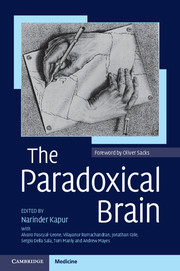Book contents
- Frontmatter
- Contents
- Acknowledgements
- Preface
- Foreword
- Author affiliations
- Abbreviations
- 1 The paradoxical nature of nature
- 2 Paradoxical effects of sensory loss
- 3 Paradoxical functional facilitation and recovery in neurological and psychiatric conditions
- 4 Paradoxes in neurorehabilitation
- 5 The paradoxical self
- 6 Paradoxical psychological functioning in early child development
- 7 Cognitive ageing: a positive perspective
- 8 Paradoxes of learning and memory
- 9 The paradox of human expertise: why experts get it wrong
- 10 Paradoxes in Parkinson's disease and other movement disorders
- 11 Paradoxical phenomena in epilepsy
- 12 Paradoxical creativity and adjustment in neurological conditions
- 13 Paradoxical functional facilitation with noninvasive brain stimulation
- 14 Unexpected benefits of allergies and cigarette smoking: two examples of paradox in neuroepidemiology
- 15 The paradox of autism: why does disability sometimes give rise to talent?
- 16 Paradoxes in creativity and psychiatric conditions
- 17 The paradox of psychosurgery to treat mental disorders
- 18 The paradox of electroconvulsive therapy
- 19 Paradoxes of comparative cognition
- 20 Paradoxical phenomena in brain plasticity
- 21 Immature neurons in the adult brain. Breaking all the rules
- 22 The paradoxical hippocampus: when forgetting helps learning
- 23 Paradoxical effects of drugs on cognitive function: the neuropsychopharmacology of the dopamine and other neurotransmitter systems
- 24 The paradoxical brain – so what?
- Index
- References
3 - Paradoxical functional facilitation and recovery in neurological and psychiatric conditions
Published online by Cambridge University Press: 05 December 2011
- Frontmatter
- Contents
- Acknowledgements
- Preface
- Foreword
- Author affiliations
- Abbreviations
- 1 The paradoxical nature of nature
- 2 Paradoxical effects of sensory loss
- 3 Paradoxical functional facilitation and recovery in neurological and psychiatric conditions
- 4 Paradoxes in neurorehabilitation
- 5 The paradoxical self
- 6 Paradoxical psychological functioning in early child development
- 7 Cognitive ageing: a positive perspective
- 8 Paradoxes of learning and memory
- 9 The paradox of human expertise: why experts get it wrong
- 10 Paradoxes in Parkinson's disease and other movement disorders
- 11 Paradoxical phenomena in epilepsy
- 12 Paradoxical creativity and adjustment in neurological conditions
- 13 Paradoxical functional facilitation with noninvasive brain stimulation
- 14 Unexpected benefits of allergies and cigarette smoking: two examples of paradox in neuroepidemiology
- 15 The paradox of autism: why does disability sometimes give rise to talent?
- 16 Paradoxes in creativity and psychiatric conditions
- 17 The paradox of psychosurgery to treat mental disorders
- 18 The paradox of electroconvulsive therapy
- 19 Paradoxes of comparative cognition
- 20 Paradoxical phenomena in brain plasticity
- 21 Immature neurons in the adult brain. Breaking all the rules
- 22 The paradoxical hippocampus: when forgetting helps learning
- 23 Paradoxical effects of drugs on cognitive function: the neuropsychopharmacology of the dopamine and other neurotransmitter systems
- 24 The paradoxical brain – so what?
- Index
- References
Summary
Summary
In neurological conditions, the major sets of paradoxical cognitive phenomena generally take one of five forms: (1) enhanced cognitive performance of neurological patients vis-à-vis neurologically intact individuals (‘lesion facilitation’), and (2) alleviation or restoration to normal of a particular cognitive deficit following the occurrence of a second brain lesion (‘double-hit recovery’). (3) A third set of paradoxical cognitive phenomena represents what may be termed ‘hinder–help effects’, where a variable that produces facilitation or detriment of performance in healthy participants results in opposite effects in neurological patients. (4) A fourth form of paradox relates to anomalies in the usual relationship between the presence/size of a brain lesion and the degree of cognitive deficit (‘lesion–load paradox’). (5) A fifth paradox is where there may appear to be direct or indirect benefits for long-term neurological outcome as the result of specific cognitive deficits being present (‘paradoxical positive outcome’). Discussion of neurological conditions will mainly be concerned with the first two sets of paradoxical phenomena, although the remaining three sets will also be reviewed briefly. In psychiatric disorders, analogous paradoxical phenomena have mainly been found in instances of enhanced cognitive performance in conditions such as depression and schizophrenia vis-à-vis healthy control participants, and also in reports of ‘post-traumatic growth’ after a major psychiatric illness or negative life events.
Introduction
As outlined in Chapter 1, the study of brain–behaviour relationships from cases of cerebral pathology has traditionally been embedded in the lesion-deficit model.
- Type
- Chapter
- Information
- The Paradoxical Brain , pp. 40 - 73Publisher: Cambridge University PressPrint publication year: 2011



